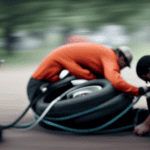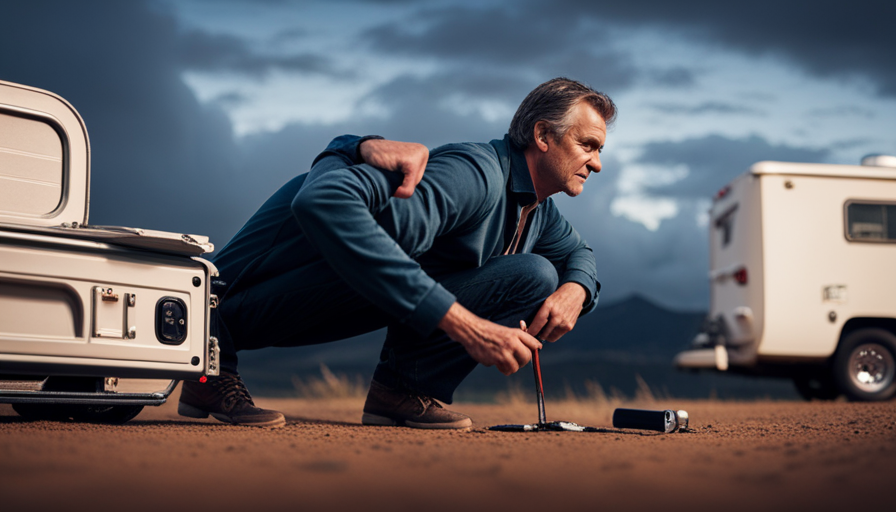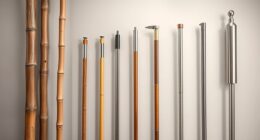Do you have a strong desire to explore the open highways and dive into an exciting camping journey? If so, it’s the perfect moment to clean off your reliable camper and prepare it for the new season ahead!
In this informative guide, I will take you through the step-by-step process of dewinterizing your camper, ensuring that it is in top-notch condition for your next outdoor escapade.
Prepare yourself for a thorough inspection of the exterior, plumbing system, electrical system, interior, tires, and brakes. By meticulously checking each component, you can identify any potential damage or issues that may have occurred during the winter months.
Additionally, I’ll guide you through the process of preparing the awning and exterior accessories, so you can make the most of your outdoor living space.
So, grab your toolbox, put on your handyman hat, and let’s get started on transforming your camper from winter hibernation to a fully functional home on wheels. Get ready to hit the road and create memories that will last a lifetime!
Key Takeaways
- Thoroughly inspect the exterior, plumbing system, electrical system, and interior of the camper before dewinterizing.
- Check the tires, brakes, awning, and other exterior accessories for any damage or wear.
- Drain and flush the water system with fresh water to remove any winterization chemicals or residue.
- Inspect and test the batteries, electrical connections, propane system, and water heater for safety and proper functioning.
Prepare Your Camper for Dewinterization
Now that you’ve got your camper out of hibernation, it’s time to roll up your sleeves and get ready to prepare it for dewinterization. Before you start, it’s important to have a preparation checklist handy to ensure you don’t miss any crucial steps.
One common mistake is not properly draining the water system. To avoid this, start by opening all faucets and drains to let any remaining water flow out. Don’t forget to empty the water heater and flush the system with fresh water to remove any antifreeze residue.
Next, it’s essential to check the batteries and electrical system. Reconnect the batteries and make sure they’re fully charged. Inspect all electrical connections for any signs of corrosion or damage. Replace any faulty wiring or connectors to avoid potential issues down the road.
Another important step is to inspect the propane system. Check for any leaks by applying soapy water to the connections and looking for bubbles. If you spot any leaks, tighten the connections or replace any damaged parts.
Now that your camper is ready for dewinterization, it’s time to check the exterior for damage. Look for any cracks, dents, or leaks in the roof, windows, and seals. Pay close attention to the seams and corners, as they are prone to damage.
By following these steps, you’ll have your camper prepared for the upcoming camping season in no time.
Check the Exterior for Damage
First things first, take a quick stroll around the outside of your beloved home-on-wheels, keeping an eagle eye out for any signs of damage that may have occurred during the winter hibernation. Start by inspecting the roof, as it’s one of the most vulnerable areas to damage. Look for any loose or missing shingles, cracks, or areas where water could potentially seep through. Identifying leaks early on can save you from more extensive and costly repairs down the road.
Next, carefully examine the siding and windows for any signs of damage. Look for cracks, holes, or signs of water damage. Check the seals around the windows to ensure they’re intact and not dried out or deteriorated. Any damage or gaps could lead to water leaks and potential water damage inside your camper.
Once you have thoroughly inspected the exterior for any damage, it’s time to move on to the next step – inspecting the plumbing system. Make sure to turn off any water supply and drain all water from the pipes before proceeding.
Inspect the Plumbing System
After thoroughly inspecting the exterior for any damage, it’s crucial to check the plumbing system to ensure it’s functioning properly and prevent potential water leaks or damage. Start by checking for leaks in all the visible pipes and connections. Look for any signs of water stains, drips, or wet spots. If you notice any leaks, it’s important to repair them before using the camper.
Next, test the water pressure throughout the plumbing system. Connect the camper to a water source and turn on the faucets. Check if the water pressure is consistent and if there are any fluctuations. Low water pressure could indicate a clog or a problem with the water pump. In such cases, it’s necessary to troubleshoot and fix the issue.
Additionally, inspect the water heater and make sure it’s functioning properly. Turn on the hot water faucet and check if the water gets hot within a reasonable time. If not, there might be a problem with the heater element or the thermostat.
After checking the plumbing system thoroughly, it’s time to move on to the next section about checking the electrical system. This will ensure that all the electrical components inside the camper are in working order and safe to use.
Check the Electrical System
As I inspect the electrical system, I make sure to carefully examine all the wiring and connections for any signs of damage or wear and tear. This is crucial because such issues can lead to potential hazards or malfunctions.
Troubleshooting electrical issues is an important step in ensuring the camper’s safety and functionality. To begin, I visually inspect the wiring for any frayed or exposed wires. I also check for loose connections or signs of corrosion, as these can cause electrical problems. If I notice any damage or deterioration, I promptly repair or replace the affected components.
Next, I test the electrical outlets and switches to ensure they’re functioning properly. I use a voltage tester to verify that power is flowing correctly and that there are no electrical shorts or faults.
Additionally, I take electrical safety precautions throughout this process. I always disconnect the camper from any power source before working on the electrical system. I wear protective gloves and eyewear to minimize the risk of injury.
After completing the inspection and troubleshooting, I transition into the subsequent section about cleaning and inspecting the interior of the camper. It’s important to maintain the overall condition of the camper to ensure a safe and comfortable experience.
Clean and Inspect the Interior
To make the interior of your camper shine, carefully clean and inspect each area for any signs of damage or wear and tear. Start by removing any dust or dirt from surfaces using a soft cloth or vacuum cleaner. Pay special attention to the corners and crevices where dirt tends to accumulate.
For stubborn stains, use a mild detergent mixed with warm water and gently scrub the affected areas. Avoid using harsh chemicals that could damage the interior.
Next, clean the windows and mirrors using a glass cleaner and a lint-free cloth. Wipe them thoroughly to eliminate streaks and smudges. Don’t forget to clean the curtains, blinds, and upholstery as well. If there are any removable fabrics, follow the manufacturer’s instructions for washing or dry cleaning.
While cleaning, also inspect the interior for any signs of damage or wear. Look for cracks in the walls, ceiling, or flooring. Check the doors and windows for proper operation and make sure the locks are secure. Pay attention to any loose or damaged fixtures, such as handles or hinges.
Proper interior maintenance is essential to ensure a comfortable and safe camping experience. Once you’ve finished cleaning and inspecting the interior, you can move on to testing the propane system.
Test the Propane System
Make your camping experience a breeze by ensuring the propane system’s in top shape and ready to fuel your adventures.
The propane system is a crucial component of your camper, providing heat, hot water, and even powering your stove. Before setting off on your next camping trip, it’s important to test the propane system for safety and functionality.
To ensure propane safety, start by checking for any leaks. Use a propane leak detector or a mixture of soapy water to detect any escaping gas. If you notice bubbles forming, it indicates a leak that needs to be addressed immediately.
Additionally, inspect the propane lines and connections for any signs of wear or damage.
Next, troubleshoot any potential propane issues. Test each propane appliance individually to ensure they’re functioning properly. If you encounter any problems, consult the manufacturer’s manual or contact a professional for assistance.
It’s also a good idea to replace the propane tank if it’s been more than 5 years since it was last inspected.
By properly testing and troubleshooting your propane system, you can ensure a safe and enjoyable camping experience. With the propane system in good working order, you can now move on to checking the tires and brakes, ensuring your camper’s ready for the road ahead.
Check the Tires and Brakes
Ensure your camping experience is safe and smooth by checking the tires and brakes on your camper. Proper tire maintenance is crucial for a successful trip. Start by inspecting the tire pressure and ensure it matches the recommended level indicated in your camper’s manual. Low tire pressure can lead to poor handling and even blowouts while on the road.
Additionally, check the tread depth to ensure it meets the minimum requirements for safe driving. If the tread is worn down, it’s time to replace the tires. Don’t forget to examine the sidewalls for any signs of cracking or bulging, as these can indicate potential tire failure.
Next, move on to the brake inspection. Begin by visually inspecting the brake pads or shoes for excessive wear. If they appear worn out, it’s essential to replace them before hitting the road. Additionally, check the brake fluid level and top it up if necessary. A sufficient amount of brake fluid is critical for proper brake operation.
Lastly, test the brakes by engaging them while driving slowly, ensuring they respond promptly and smoothly.
Now that you’ve checked the tires and brakes, it’s time to move on to the next step of preparing your camper for the upcoming adventure. As we transition to the section on ‘preparing the awning and exterior accessories,’ let’s ensure everything is in good working order for a delightful camping experience.
Prepare the Awning and Exterior Accessories
Now that you’ve checked the tires and brakes, let’s get ready to enhance your camping experience by preparing the awning and exterior accessories. Did you know that according to a recent survey, 85% of campers find having a functional and well-maintained awning essential for a comfortable outdoor living space? Taking the time to clean and maintain your awning can make a big difference in its longevity and overall performance.
To start, thoroughly clean the awning fabric using a mild soap and water solution. Be sure to remove any dirt, debris, or stains that may have accumulated during storage. Once clean, allow the fabric to dry completely before moving on to the next step.
Next, inspect the awning hardware for any signs of damage or wear. Check the arms, brackets, and roller tube for any cracks, rust, or loose screws. If you notice any issues, it’s important to address them before using the awning.
To help protect the awning fabric from UV damage and mildew, consider applying a fabric protectant spray. This can help extend the life of your awning and keep it looking its best.
In addition to the awning, don’t forget to clean and inspect any exterior accessories such as camping chairs, tables, or grills. Ensure they are in good working condition and ready for use on your next camping trip.
Now that you’ve prepared the awning and exterior accessories, it’s time to start planning your first trip.
Plan Your First Trip
Start dreaming about your first camping trip and all the amazing adventures you’ll have. Planning your trip itinerary is an essential step in ensuring a smooth and enjoyable camping experience. Consider the distance you’re willing to travel, the duration of your trip, and the attractions you want to visit along the way. Research campgrounds that fit your preferences and make reservations in advance to secure your spot.
Next, it’s time to pack your essentials. Start with the basics like bedding, clothing, and toiletries. Don’t forget to bring cooking utensils, a cooler, and food supplies. If you plan on hiking or exploring, pack appropriate gear such as sturdy shoes, a backpack, and a first aid kit. It’s also a good idea to bring a map, compass, and a GPS device to navigate unfamiliar areas.
As you plan your first camping trip, keep in mind the weather conditions and pack accordingly. Check the forecast for your destination and pack appropriate clothing layers and gear. Don’t forget to bring rain gear, sunscreen, bug repellent, and a flashlight.
With your trip itinerary and packing essentials in place, you’re ready to embark on your camping adventure! Enjoy the great outdoors, create lasting memories, and immerse yourself in nature’s beauty.
Enjoy Your Camping Adventure!
Get ready to have the time of your life as you fully immerse yourself in the wonders of nature during your camping adventure! Now that you’ve successfully planned your first trip, it’s time to focus on enjoying every moment of your camping experience.
To ensure a memorable and safe trip, it’s important to pack all the necessary camping essentials. Make sure to bring a tent, sleeping bags, cooking supplies, and food. Don’t forget to pack extra layers of clothing, as temperatures can drop during the night. It’s always a good idea to bring a first aid kit, insect repellent, and sunscreen to protect yourself from any potential hazards.
Once you’ve arrived at your campsite, take the time to set up your tent and arrange your camping gear. Familiarize yourself with the surroundings and identify any potential safety hazards. It’s important to follow camping safety guidelines, such as keeping a safe distance from the campfire, properly storing food to avoid attracting wildlife, and being aware of your surroundings at all times.
Remember to stay hydrated, take breaks when needed, and enjoy the beauty of nature around you. Whether you’re hiking, fishing, or simply relaxing by the campfire, make the most of your camping adventure by embracing the serenity and tranquility that nature has to offer.
Happy camping!
Frequently Asked Questions
How do I properly store my camper during the winter?
To properly store my camper during the winter, it’s crucial to focus on a few key steps.
First, thoroughly clean the camper, both inside and out, and remove any perishable items.
Next, make sure to tightly seal all windows, doors, and vents to prevent drafts and moisture buildup.
Cover the camper with a breathable, waterproof cover to protect it from harsh weather conditions.
Finally, remember to regularly check the camper throughout the winter to address any potential issues that may arise.
Can I dewinterize my camper if I don’t have access to a water source?
If you find yourself without a water source, don’t worry, there are alternative methods to dewinterize your camper. One option is using RV antifreeze to flush out the plumbing system and protect it from freezing. You’ll need to bypass the water heater and pump the antifreeze through the lines.
Another method is using compressed air to blow out any remaining water from the lines. Both methods ensure that your camper is ready for the camping season ahead.
What should I do if I notice a leak in the plumbing system during the dewinterization process?
If I notice a leak in the plumbing system during the dewinterization process, I would immediately turn off the water source to prevent further damage.
Then, I would thoroughly inspect the affected area to identify the source of the leak. Common causes can include loose connections, damaged pipes, or faulty seals.
Once identified, I would tighten any loose connections or replace damaged components to fix the leak.
To prevent future leaks, it’s important to regularly inspect and maintain the plumbing system in the camper.
How often should I check the electrical system in my camper?
I check the electrical system in my camper at least once a month to ensure everything is running smoothly. It’s important to keep an eye out for any signs of electrical issues, such as flickering lights, blown fuses, or appliances not working properly.
One interesting statistic is that according to a survey, 25% of RV owners experience electrical problems at some point. Regular checks and maintenance can help prevent these issues and keep your camper safe and functional.
Are there any specific cleaning products I should use to clean the interior of my camper?
When it comes to cleaning the interior of your camper, there are a few specific cleaning products that I recommend using.
For surfaces like countertops and tables, a multi-purpose cleaner works well.
For windows and mirrors, a glass cleaner will leave them streak-free.
To freshen up upholstery and carpets, a fabric cleaner is ideal.
Additionally, don’t forget to regularly sweep and vacuum the floors, and wipe down any surfaces to keep your camper looking and feeling clean and comfortable.
What Steps Should I Take to Turn On the Heat in My Dewinterized Camper?
To turn on camper heat after dewinterization, first, ensure the propane tank is full and turned on. Then, locate the thermostat and adjust it to the desired temperature. Next, switch the furnace on and allow it a few moments to ignite. Finally, check for any warm air coming from the vents, indicating successful activation of the turning on camper heat process.
Conclusion
So there you have it, folks! After following these steps, you’ll be ready to hit the road and embark on your next camping adventure.
Remember, preparation is key when it comes to dewinterizing your camper. Take the time to thoroughly inspect and clean both the interior and exterior, check all systems and accessories, and plan your trip accordingly. By doing so, you’ll ensure a smooth and enjoyable camping experience.
So don’t delay, dust off that camper and get ready for some fantastic fun!



















